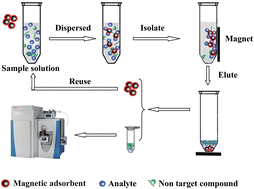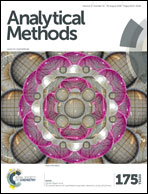Highly sensitive mass spectrometric detection of flunitrazepam using magnetic graphene framework enrichment†
Abstract
In this paper, a magnetic graphene framework (MGF) material was prepared and used as a magnetic solid-phase extraction adsorbent for the preconcentration of flunitrazepam from beverage samples prior to high resolution mass spectrometric determination. The MGF nanocomposite was characterized by scanning electron microscopy, transmission electron microscopy, vibrating sample magnetometry, and N2 adsorption. The high surface area and specific framework structure of the MGF endows it with a high adsorption capacity. Several experimental parameters affecting the extraction efficiencies, such as the amount of the adsorbent, extraction time, sample pH and desorption conditions were optimized. Under the optimum conditions, a good linearity was achieved in the concentration range of 0.01–1.0 nmol L−1 for ginger ale and 0.05–5.0 nmol L−1 for the Pure tea sample with the correlation coefficients larger than 0.9875. The limits of detection of the method were 0.001 nmol L−1 (0.3 ng L−1) for ginger ale and 0.005 nmol L−1 (1.5 ng L−1) for Pure tea, which is about 3–4 orders of magnitude lower than those of literature reports. The recoveries of the method for the analytes were in the range of 92.0–102.5%. The results indicated that the developed method was efficient for the preconcentration of trace levels of flunitrazepam from beverage samples. The MGF adsorbent would have a significant application potential for the enrichment of other abused drugs and organic pollutants in different samples.


 Please wait while we load your content...
Please wait while we load your content...